about me
my webmark
Tel deadlines
my know_base
my notebook
-------
my home
-------
my institute:
YNAO
my group:
YNAO-BPS
|
|
Highlights of my research : (updated by May 25, 2016)
| Chem |
Facts: Grains in turbulent medium should be moving through the gas, which could have astrochemical consequence. We tested the astrochemical effects of turbulent grain motion in dark cloud (DC), molecular cloud (MC) and cold neutral medium (CNM) models with a new gas-grain astrochemical code 'ggchem'. We have added new physics in the chemical model which played key roles in realing the grain motion effects: ion accretion, grain charging, photo electron ejection.
Results: We found that the grain motion has profound astrochemical effects in both DC and CNM models, affecting the abundances of some gaseous and surface species by orders of magnitude. A comparison of the change of abundance relative to models without grain motion is given below.
Conclusions: The results confirm that the turbulent grain motion should be considered in routine astrochemical modeling practices.
(Ge, J.X.; He, J.H.; Yan, H.R., 2016MNRAS.455.3570G)
|
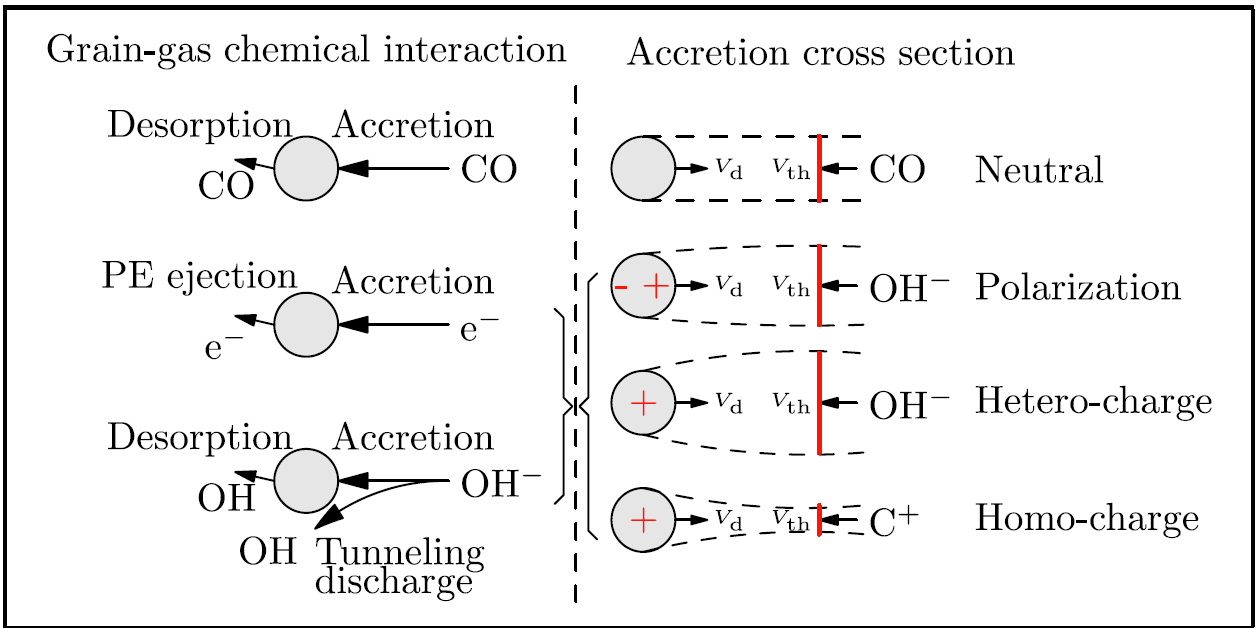  |
|
|

Chem in SFR |
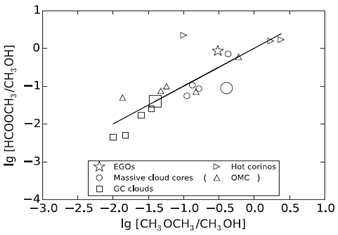
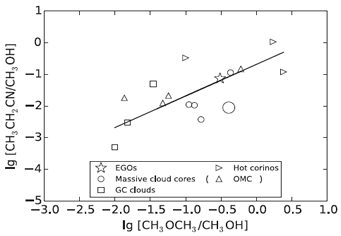
|
Facts: Among our millimeter line survey of Splitzer Glimpse Extended Green Objects (EGOs) , 29 of them show multiple transition lines from at least one of the four complex organic molecules (COMs): CH3OH,
CH3OCH3, HCOOCH3 and CH3CH2CN. We determined their column density, excitation temperature and beam filling factor with the population diagram method and compared the results with that of other cloud cores from literature.
Results: Uniform properties are found for the EGOs: Tex ~ 44K, linear size ~ 0.036 pc, beam averaged Methanol abundance X(CH3OH) ~ 10^9. Correlations of the abundance ratios are found among different kinds of cloud cores (see in the figures in the left).
Conclusions: The chemical properties of the EGO cloud cores lie between those of hot cores and
hot corinos. However, the abundances and abundance ratios of the four species cannot be
explained satisfactorily by recent chemical models, either among EGO cloud cores or among
the various types of cloud core from literature.
(Ge, J.X.,; He, J.H.; Chen, X.; Takahashi, S. 2014MNRAS.445.1170G)
|
|
|

|
|
| Evol. Star |
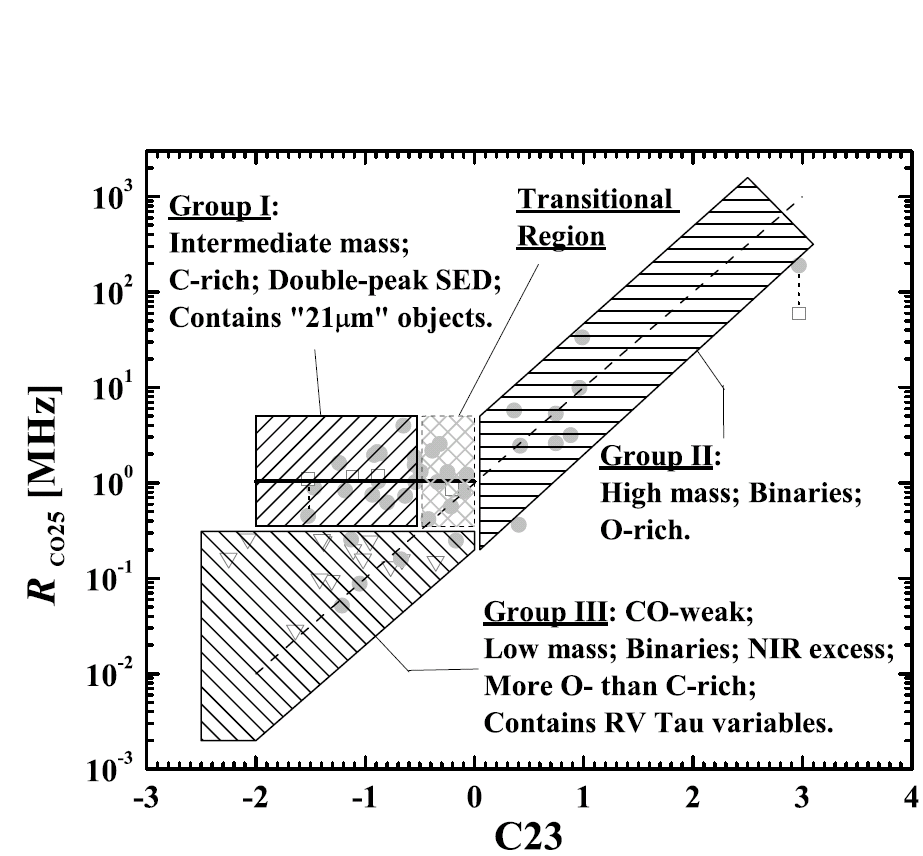
|
Facts: Post-AGB is a brief transitional evolutionary stage of stars in the 2-8 Msun mass range. We study the coevolution of dust and gas in their circumstellar envelopes through comparing their CO 2-1 line strengths with dust IR fluxes
Results: We define a naval CO-IR diagram on which to reveal the relationship of dust and gas of different postAGB stars. We observed CO 2-1 line toward a sample of high Galactic latitude stars and collected literature CO 2-1 data.
Conclusions: The considered postAGB stars segregate into three groups (CO-IR groups): I, II and III, on the CO-IR diagrams. The distribution of postAGB stars and AGB and PNs agree well with the AGB-postAGB-PN evolutionary sequence. The three CO-IR groups of postAGB stars show distinct properties such as chemical types, spectral types, binarity, circumstellar expansion velocities, and SED types. The CO-IR diagram is proven to be a new useful tool analysing dust and gas coevolution during the fast postAGB evolutionary stage.
(He, J.H.; Szczerba, R.; Hasegawa, T. I.; Schmidt M.R. 2014ApJS..210...26H)
|
|
|

| SFR |
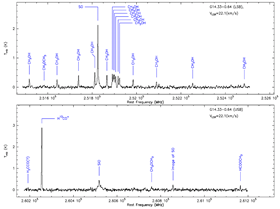
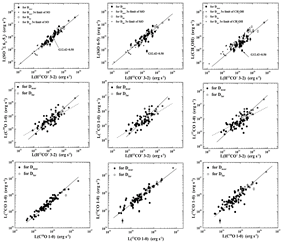
|
Facts: Splitzer Glimpse Extended Green Objects (EGOs) are a
new sample of massive star formation regions. We surveyed millimeter molecular line emission toward 89 EGOs in two 1GHz wide bands around wavelengths of 1.1um, using the Arizona Radio Observatory 10m
telescope.
Results: We detected molecular lines from 8 species. The strongest line, the dense gas tracer H13CO+, is detected in 70 of the 89 EGOs. An example spectral plot is shown in the left top figure.
Conclusions: The results confirm that most of the EGOs are indeed associated with dense gas and many of them are experiencing active shocks (perhaps due to outflows). The line luminosities of the very different tracers (H13CO+, SO, CH3OH for dense gas, SiO 6-5 for shocks, and CH3OH, CH3OCH3, HCOOCH3 and CH3CH2CN for oganics in hot gas) are all linear correlated. We explain this with such a physical picture:
1) All clouds have similar physical structures over many size scales;
2) Most of the outflow shocks are produced inside of the natal clouds of the forming massive stars.
(He, J.H.; Takahashi, S.; Chen, X., 2012ApJS..202....1H)
|
|
|

| Evol. Star |
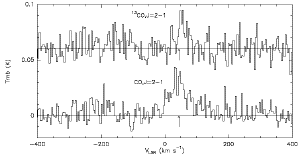
|
Facts: Water fountain star is a
small group of very young post-AGB stars showing both AGB circumstellar
envelope and high velocity bipolar H2O maser jets. We've detected for the
first time the 12CO and 13CO
emission in J=2-1 rotational transition towards a water fountain
star, IRAS 16342-3814, using the Arizona Radio Observatory 10m
telescope.
(He, J.H.; Imai, H.; Hasegawa, T.I.; Campbell, S.W.; Nakashima, J. A&A, 2008A&A...488L..21H) |
|
Conclusions: The broad CO,2-1 line (envelope expansion velocity, Vexp =
46 km/s) and it's velocity relationship to known H2O
and OH masers data constrains the location of the CO emitting region to be at
the base of optical bipolar lobes (found through optical and
near infrared imaging). The very low 12CO/13CO
line intensity ratio possibly indicates a massive AGB progenitor,
but more observations are necessary to address the opacity effects in the
12CO line. However, the peculiar counter-Galactic
rotation spatial motion of this star seems to favor low mass star
AGB progenitor.
|

Evol.
Star |
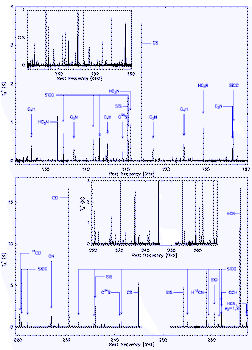
|
We performed a millimeter spectral line survey of an
archetypal carbon rich AGB star, CW Leo ( = IRC +10216), to explore the molecular contents of its
circum-stellar envelope. In our surveyed 1.3 mm and 2mm windows, the molecular line emission is dominated by strong lines from
14
molecular species: CO, HCN, H13CN, CS, SiS, SiO,
CCH, CN, 13CO, HC3N, SiCC, C4H, C3N,
C34S. (see in the left figure)
(He J. H., Dinh-V-Trung, Kwok S., Mueller H. S .P., Zhang Y., Hasegawa T., Peng T. C. and
Huang Y. C., 2008ApJS..177..275H)
|
 |
Evol.
Star |
This is the column density patterns in the
circumstellar envelope of an AGB star residing in a wide binary system. The patterns are induced by orbital motion
of the AGB star. The patterns mainly depend on two physical/geometrical
parameters: eccentricity of the binary orbit e and outflow to orbit motion velocity ratio gamma.
The patterns look different from different inclination angles (zeta)
and azimuth angle (see in appendix of the following paper).
(He J. H., 2007, A&A, 467, 1081 ADS)
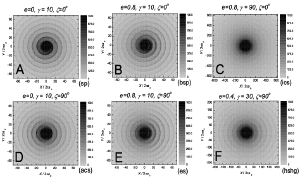
|
Shown are Typical patterns:
|
|
sp -- Spiral pattern
|
|
bsp -- Broken spiral pattern
|
|
ics -- Incomplete
circular shells
|
|
acs -- Alternative concentric
shells
|
|
es -- Egg shells
|
|
hshg -- Half shell half gap
|
|
|
|

|
![]()